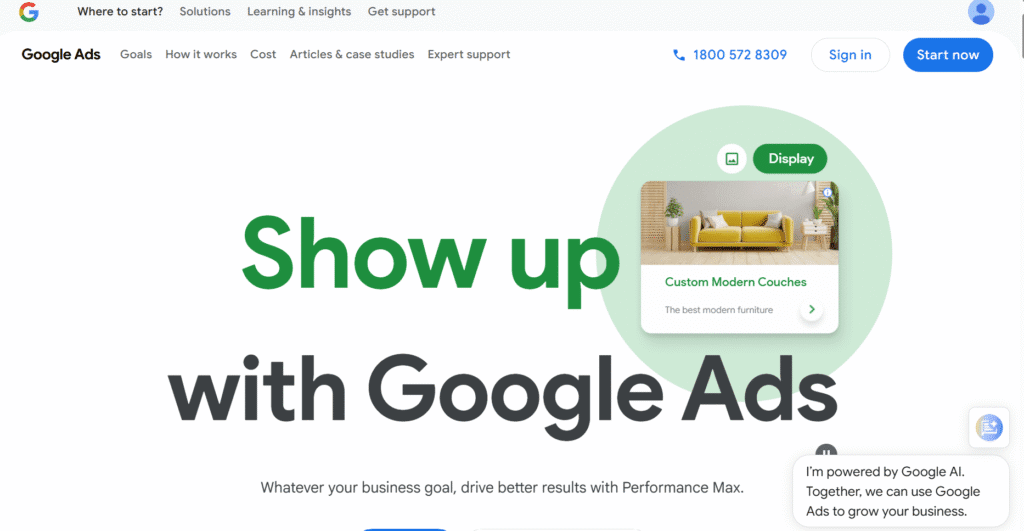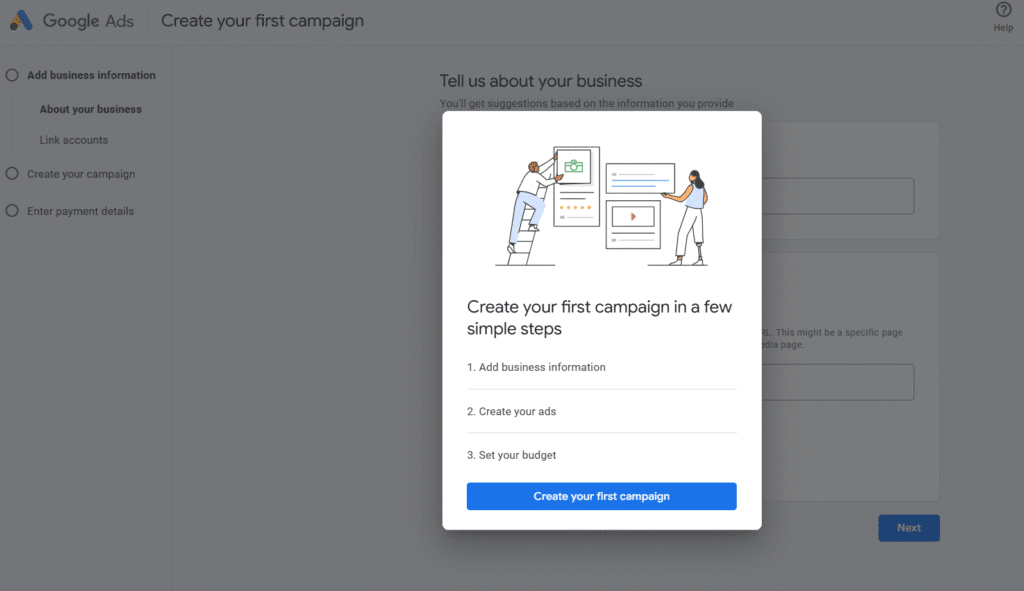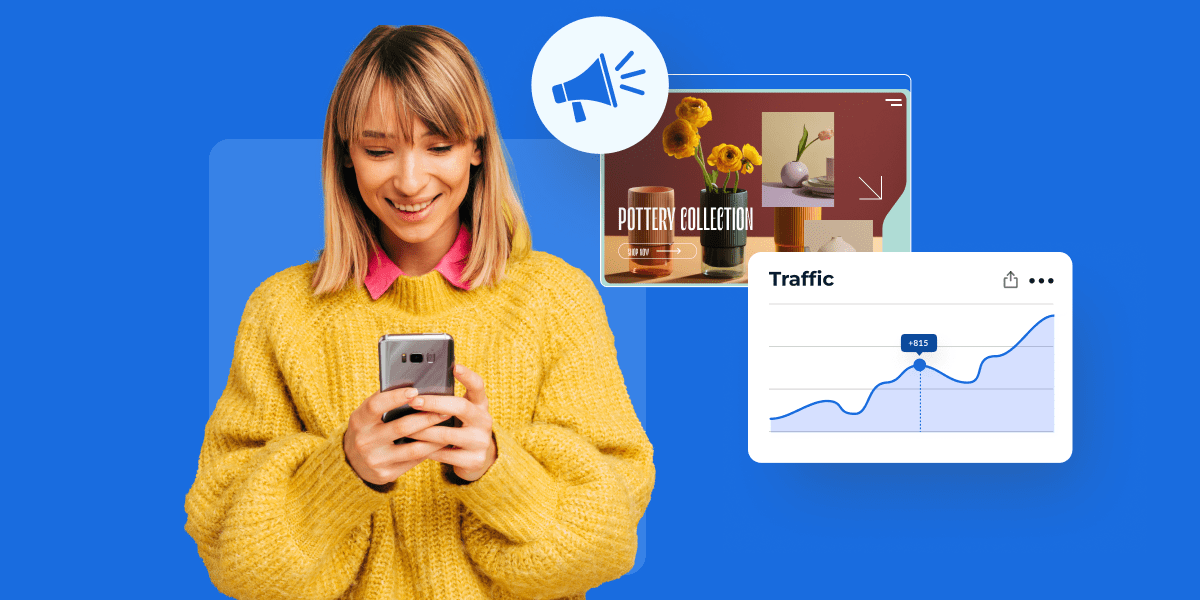Key highlights
- Learn the basics of setting up and customizing your Google Ads account for real results.
- Know your options, from setting your own price to letting Google do the heavy lifting.
- Adjust your ads based on devices, locations or even times of day to get a better return on your budget.
- Create ads that actually get noticed and grab your audience’s attention to inspire them to take action.
- See how to match your ad’s promise with what visitors find on your landing page.
What makes some brands skyrocket to the top of search results while others fade into the background? It’s impossible to spend time on the internet without encountering advertisements. You see them appear in your search results, social media, mobile apps and even on your favorite news blogs. Google Ads (formerly Google AdWords) holds the answer.
At the forefront of the online advertising industry, with a 79% market share, is Google. Its online advertising platform, Google Ads, is one of the most popular options for small business owners who want their ads to be seen by billions of internet users. Take a cue from companies like Airbnb, which built their early growth using Google AdWords Ads to connect with eager travelers.
In this blog, you’ll discover what Google Ads is, exactly how to create ads in Google AdWords and even learn smart tricks for how do you advertise on Google. Let’s get started.
What is Google Ads?
Google Ads (formerly Google AdWords) is an online advertising platform that helps you create and display ads across the internet. Advertisers can use a range of ad formats and target different online locations to reach users who are likely to engage.
- Paid Placement: Unlike SEO (Search Engine Optimization), where you optimize your website to appear in search results naturally, Google Ads requires you to pay for your ads to show up in search engine results.
- Strategic Visibility: The main goal in both Google Ads and SEO is to help your content be seen by more people, but the approach with Google Ads is direct and paid.
Launched in 2000, just two years after Google’s search engine debut, Google Ads initially served as a means for businesses to display ads within Google search results. Over time, it has undergone significant expansion.
- Wider reach: Today, Google Ads can show ads on platforms owned by Alphabet (Google’s parent company), including YouTube, Google Maps, mobile apps and numerous websites across its partner network.
- Massive audience: Your ads have the potential to reach billions. For example, the Google search homepage alone gets over 80 billion visits per month.
Is Google Ads the same as AdWords?
In short, yes! Google Ads is the new name for Google AdWords. In 2018, Google rebranded AdWords to Google Ads to better reflect everything the platform offers beyond just “words” in search ads. Today, Google Ads lets you run search ads, display ads, YouTube ads, Shopping campaigns, app ads and more from one place.
So, if you still see the term ‘Google AdWords’ in tutorials or screenshots, it’s referring to the same advertising platform we now call Google Ads. The features have expanded, the interface has changed, but the core idea is the same.
| Google AdWords | Google Ads |
| Original name (before 2018) | Rebranded name (after 2018) |
| Focused on search advertising | Includes search, YouTube, Gmail, Display Network campaigns |
| Same core platform and features | Visual updates, more campaign types, same core functionality |
In summary, Google Ads is simply the new name for AdWords. The main processes creating campaigns, managing budgets, selecting keywords and tracking results remain the same. Any tutorials or guides referencing “AdWords” are still relevant for learning how to create ads in Google Ads today.
Note: Whether you see “Google AdWords” or “Google Ads,” you’re using the same platform and learning the same key skills for online advertising success.
Why use Google Ads?
Google Ads offers powerful advantages for beginners and businesses seeking to drive targeted traffic, boost brand visibility and achieve measurable marketing results. Here are some of the top reasons to use Google Ads for your advertising campaigns:
- Instant visibility: Your ads can appear at the top of search results, reaching potential customers immediately—unlike SEO, which often takes months to show results.
- Targeted reach: Fine-tune who sees your ads by choosing specific locations, demographics, interests and even user search behavior. This ensures your budget is spent on those most likely to engage with your business.
- Budget control: Google Ads lets you set daily and campaign-level budgets, so you can start small and scale as you see performance, no matter your business size.
- Measurable ROI: Every click and conversion is tracked, allowing you to see exactly how your ads are performing and optimizing for better results.
- Flexibility: Whether you’re launching a new website, running time-sensitive promotions or boosting holiday sales, Google Ads adapts to your goals and timeline.
As someone who values seamless website performance, we understand how crucial it is to have reliable web hosting when running effective ad campaigns. When your ads bring in a surge of visitors, you need a hosting partner that keeps your site fast and accessible.
That’s where Bluehost comes in. Our hosting plans and WordPress bundles are designed to handle increased traffic from successful Google Ads campaigns. With Bluehost, you get a dependable foundation to turn those valuable ad clicks into loyal customers.
How do Google Ads Work?
Google Ads uses a number of factors to determine how and when adverts from your campaign are displayed, including the following measures.
- Quality score
- Advert bid
- Ad Rank
Let’s understand each in detail.
1. Quality score
The first of these factors is the quality score. This score is a measure of the quality of your advert based on three metrics:
- The relevance of your ad keywords to a user’s search intent.
- The relevance of the landing page your advert leads to when a potential customer clicks on it.
- The expected click-through rate (CTR) is the ratio of ad clicks to ad views.
Google Ads uses a scale of 1–10 to measure the quality of your ads. The three metrics have been measured against other ads from the past 90 days that use similar keywords.
2. Advert bid
Next is your advert’s bid. It refers to the maximum amount you are willing to pay Google each time someone interacts with any of your adverts. These interactions vary depending on the ad type, which also affects the focus of your bidding strategy.
These are the major interaction types that you can choose to bid for:
- Clicks: Here, the focus is on having users click on your ad to go to a website or landing page. This focus will use a pay-per-click (PPC) or cost-per-click (CPC) bidding model.
- Impressions: This campaign type focuses on impressions or views, and since the numbers are much higher, the bidding is based on cost-per-thousand viewable impressions (vCPM).
- Conversions: The bidding here is done by cost-per-action (CPA) and is based on the user completing a signup form or completing some other activity based on their interaction with your ad.
- Views: this area of focus is only for video ads, and the bidding is measured in cost-per-view (CPV).
3. Ad Rank
Google Ads combines your quality score with the maximum bid to determine an Ad Rank for your campaign. The Ad Rank is entered into an auction with those from several other competing ad campaigns to determine if they will appear on a search engine results page (SERP) or other ad display locations.
Other factors can affect your ad rank, like the competitiveness of the auction (based on the number of adverts with matching rank scores, or the ad rank threshold, which is the minimum score an ad rank must meet to be displayed. That means an advertiser only pays the publisher (Google in this case) when a target clicks or interacts with the advert.
That differs from other models, where you pay based on the number of completed transactions or impressions. Based on all these factors, your Google ads determine when your ad is displayed and where it will appear.
Google Ads campaign types
There are five major types of ad campaigns you can run with Google Ads as part of your search engine marketing strategy.
- Search campaigns
- Display campaigns
- Video campaigns
- Shopping campaigns
- App campaigns
Let’s understand each in detail.
1. Search campaigns
This is the original type of ad campaign and is displayed on Google’s search engine results page with the rest of the results of a search query. These ads are usually text-based and, when displayed, they appear as a regular part of the search results.
Your ads will be displayed with organic results when a user’s search queries match the specified keywords for your campaign (if your Ad Rank is high enough for the keywords). That applies to Google search results or other websites on the Google Search Network.
Search campaign ad types primarily utilize the PPC model, ensuring you only pay when users find your ads useful enough to click on them.
2. Display campaigns
Display ad campaigns differ in that their primary goal is brand visibility, rather than clicks. Your campaign is typically in a format that attracts visual attention.
Google Ads uses its Google Display Network to ensure that ads of this type are visible not just on Google-owned properties but also on millions of other websites and online platforms. You can also use demographics and other forms of targeting to control where and how your ads are displayed on the network.
For display campaigns, you can pay for ad interactions by click (PPC), impressions (vCPM), or conversions (CPA).
3. Video campaigns
These campaign types are designed to appear on YouTube, Google’s video platform. The ads are also available in video format, allowing them to play alongside the regular video content on the platform.
Video ads are typically 6–15 seconds long to ensure they can catch a viewer’s attention, though they can be much longer. Additionally, YouTube plays them before the requested video loads and sometimes during playback, but users can skip them.
Like other campaign types, you can factor in things like location, demographics and interests to determine who sees your adverts. Payments for the ad are only made when users view your ads over a certain time limit or interact with other elements you include in the ad, like a banner or overlay.
4. Shopping campaigns
Google Ads shopping campaigns are perfect for customers with eCommerce sites or offline retail stores that need to showcase their products to a new audience. However, it requires you to jump through some hoops before advertising your products.
To create a shopping campaign, you first need to sign up for the Google Merchant Center and add your products there. Once that’s done, you can create your shopping campaign and display your ads in the search results for related keywords.
You can configure your campaign to lead to actual sales of your products or just to drive traffic to your online or physical store.
5. App campaigns
App campaigns allow you to promote Android or iOS apps by placing ads in search results, YouTube videos, websites and even on the app stores. All you need to do is create the ad campaign, specify your goals and budget and Google Ads will handle the rest.
You can use these campaigns to promote your app’s installations or drive in-app interactions, like completing an activity or making a purchase. For example, if your app is a mobile game and you just released an update for a new level, you can create an ad campaign that promotes completing the new level rather than starting the whole game.
As a result, billing for these ads is based on conversions. Leveraging these advantages when creating your first campaign in Google AdWords can give your business a strong, competitive edge and help you achieve your marketing goals efficiently.
Bluehost Google PPC goes beyond simply providing landing page hosting. It connects you with a team of dedicated Google PPC experts who are focused on helping you drive highly targeted leads for your business. These specialists work closely with you to develop and optimize your Google Ads campaigns, ensuring that every ad is strategically crafted to reach your ideal audience.
How to create a Google Ads campaign
Now that you have a solid understanding of the fundamentals of Google Ads and their key features, it’s time to dive into the practical steps of building your own campaign.
Step 1: Create a Google Ads account
Go to ads.google.com and sign in with your Google account.

Note that while setting up your new account, you’ll need to specify your business name and the online address you want visitors to be directed to.
Step 2: Create your first campaign
On the welcome screen, you’ll see a pop-up that says “Create your first campaign in a few simple steps” with three points:
- Add business information
- Create your ads
- Set your budget
Click the blue button “Create your first campaign”

These advertising goals sort of correspond to the campaign types mentioned earlier. If you choose the second option, you can choose the type of sales or leads you want and which web page on your site can perform this action.

Step 3: Craft your advert messaging
Here’s where you put down the ad’s contents that will be visible to users on the internet. There are three sections: the headline, the description and the call to action. Note each section has character limits.

You can add multiple versions of the headline and description to give Google Ads more combinations to test. The testing helps optimize the ad to achieve the best possible results. You can also add a phone number for calls.

You also get the option to add images to your ad messaging. That includes regular images and logos for your company or the product you’re advertising. As you add the content for your ad, you can see a small preview to the side that shows you what your ads will look like.
Step 4: Choose your keywords
Your keywords are the foundation for how Google determines who sees your ads. Google compares the terms in your keywords to its users’ search results and search history.
If there are any matches, the users with these matches in their records may receive your ads because they’ve shown interest in something related to them.

You can choose multiple keywords and specify the language you’re advertising in. Also, you can have a keyword phrase instead of just a single word. Sometimes, as you add keywords, Google will make suggestions for you.
Step 5: Select the location for your ads
You can also specify the location where you want your ads to be displayed. That helps tailor the reach of your ad campaign and makes it more likely to reach your audience.

There are two options you can use to specify locations. The first lets you choose an address and set the distance around the address you want your ads to cover. With the second option, you can choose multiple zip codes, cities or regions as your target.
There’s a small map to the right for each option that you can use to confirm the locations you pick.
Step 6: Set your campaign budget
This is how you determine the average daily spend for your campaign. The daily average affects how many times your ads can be displayed in a day if its Ad Rank is high enough.

You can choose the ad options Google recommends or select your budget. For each budget option, you can see the daily average, the max amount to be spent in a month and the estimated number of clicks per month.
When you manually set up a campaign budget, Google Ads gives you an idea of what competitors typically set as their budget for similar campaigns. That way you can balance what’s good for you and what gets results.
Step 7: Publish your campaign
Once you’ve set everything up and reviewed the details to ensure you’ve provided all the necessary information, you can launch your campaign. Before publishing, you can check the information you’ve entered for your campaign and make necessary changes.

You must also input your payment information before your campaign can launch. Google Ads doesn’t bill you immediately but waits until your budget is used up or the campaign is over before you get charged for the interactions.
Once you submit your campaign information, Google will review it to ensure it complies with its ad policies.
Best practices for an effective Google Ads campaign
Advertising aims to generate returns on your investment and turn a profit. Therefore, your advertising budget should be adequate to be effective. Additionally, you can adjust your budget based on the campaign’s effectiveness as time passes.
- Highlight your unique selling points: Clearly communicate what sets your products or services apart in your ad headlines and descriptions to attract attention.
- Conduct thorough keyword research: Choose relevant keywords that your potential customers are searching for. Use tools like Google Keyword Planner, Semrush or Moz to identify effective keywords for your Google Ads campaigns.
- Be transparent about pricing and offers: Clearly display prices or discounts to help customers make quick, informed decisions.
- Optimize for mobile users: With over 60% of global internet traffic on mobile devices, ensure your ad content, landing pages and website are fully mobile-friendly.
- Check for grammar errors: Error-free ads build trust and increase your campaign’s professionalism and effectiveness.
- Measure your ad performance: If you’re using Google Ads to drive sales or leads to your website or online store, then you should install and customize Google Analytics on your site to track conversions as well as other metrics like demographics and traffic sources.
Final thoughts
With Google Ads (formerly Google AdWords Ads), you have a powerful platform at your fingertips to elevate your business and reach new customers. By mastering the basics and following this step-by-step guide, you’ll be able to create effective campaigns that drive results.
Whether you refer to it as Ads or AdWords, Google’s clear dominance as an internet search engine and advertising giant makes its ad management platform an easy choice for promoting businesses.
Now is the perfect time to take the next step and launch your first Google Ads campaign. Need support to maximize your ROI? Bluehost ensures your Google Ads traffic converts seamlessly into lasting business growth. Start optimizing your ad strategy today!
Start with Bluehost WordPress hosting today and boost your website traffic with effective Google Ads campaigns.
FAQs
Google Ads is simply the new name for the same platform that used to be called Google AdWords Ads. The rebrand expanded the focus from only search text ads to include YouTube, Display, Shopping and app campaigns. You still create campaigns, choose keywords, set bids and track results in almost the same way.
To learn how to create ads in Google AdWords (now Google Ads), start by opening ads.google.com, creating an account and choosing your main campaign goal. Next, select your campaign type, add keywords, write your ad copy, set up a daily budget and publish your campaign. Our step-by-step guide above provides a detailed walkthrough of each of these stages.
The easiest path is to start with a single search campaign focused on one product or service. Use tightly related keywords, send traffic to a fast, relevant landing page and monitor clicks and cost per conversion. Bluehost Google PPC can pair this setup with expert management so your first campaigns are structured correctly from day one.
You can advertise on Google for free by using organic tools like SEO, Google Business Profile and content marketing instead of paid clicks. You can also take advantage of occasional Google Ads promo credits that effectively give you a limited amount of free advertising. Over time, combining strong organic visibility with smart paid Google Ads campaigns usually delivers the best growth.
Google Professional Ads usually refers to Google’s official certifications and partner programs for agencies and advanced advertisers. These credentials demonstrate an understanding of bidding, targeting and optimization at a deeper level. If you don’t want to manage everything yourself, working with a Google professional AdWords team like Bluehost Google PPC gives you access to that expertise without needing to pass the exams personally.
You can technically launch Google Ads without hosting, but slow or unreliable servers will waste your ad spend. Every click you pay for should land on a fast, secure, mobile-friendly page that loads instantly and doesn’t crash under traffic spikes. Bluehost’s WordPress hosting and Google PPC services are built to support performance-focused campaigns, so more of your paid visitors actually convert.
Google Ads lets your site appear above organic Google search results, so you’re easily found by ready-to-buy customers. With AI-powered bidding and clear text ads on any computer or device, you can reach people at the exact moment they’re searching.
Performance Max is a Google Ads campaign type that uses AI-powered automation to show your ads across Search, YouTube, Display and more. It helps you make the most of your budget by matching your products, services and inventory to users most likely to convert.
Using Performance Max in Google Ads or Google AdWords Ads, you can promote your full product inventory with smart targeting to drive sales. The AI system is powered by real-time signals, so your ads appear where shoppers are most active and ready to buy.
Start with a simple Google search campaign focused on one product or service and tightly themed keywords. As you learn how to create ads in Google AdWords, you can test different messages, share winning versions and quickly see which offers drive sales.
You don’t have to use Google professional AdWords support, but experts can help you hear customer trends, refine targeting and scale faster. They’ll review your data, ensure campaigns are correctly powered by ai insights and help turn every click you’ve found into long-term revenue.




Write A Comment